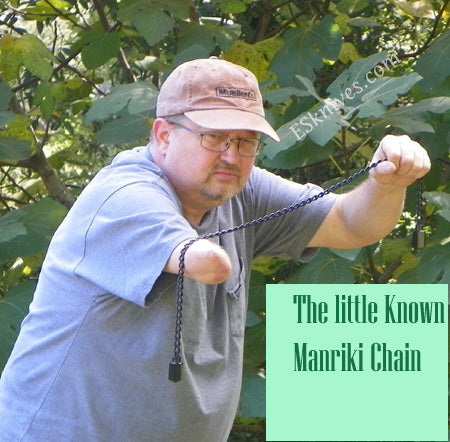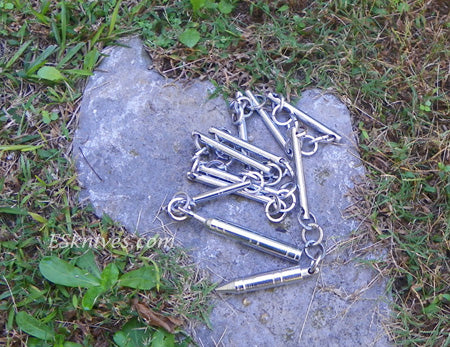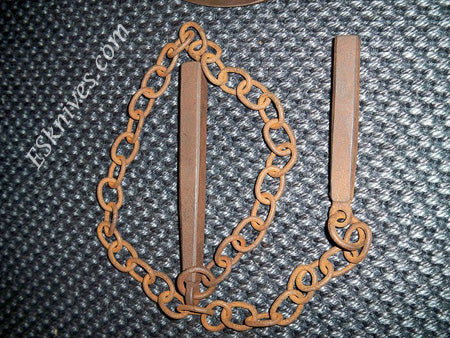Manriki chain: Little Known Weapon for Self Defense

Manriki Chains or Kusari-Fundo chains are hand held weapons consisting of a short chain with a weight connected to each end of the chain. The chain is known as the Kusari and the Fundo is the weight. There are no set designs for these chains so they come in various shapes and sizes. Manriki chains are a flexible, close range weapon that can be used to strike, snare, throw, entangle an assailant, or disable an opponents' weapon.
The names of Manriki chains have almost as many variations as the chains themselves. Known as Manriki gusari (meaning ten thousand power chain), Surujin, Suruchin Jiujiebian, Qijiebian and Sanjiebian are just a few.
The names of Manriki chains have almost as many variations as the chains themselves. Known as Manriki gusari (meaning ten thousand power chain), Surujin, Suruchin Jiujiebian, Qijiebian and Sanjiebian are just a few.

There is a Japanese, Shaolin weapon, chain whip which is a cousin to the Manriki. These chain whips are around 3 feet long with a metal handle on one end and a 4" spike on the other end. The chain itself consists of several metal rods, which are joined end-to-end by metal rings that forms a flexible chain. The are usually used for slashing or piercing an opponent. Sometimes cloth flags may be attached near the dart end of the whip and a second flag may cover the whip's handle. These flags add visual appeal and produce a rushing sound as the whip swings through the air and help stabilize the whip.

Chain Whip
It is said that a samurai named Masaki Toshimitsu Dannoshin was the head sentry at Edo castle and he fashioned the manrki in the early 1700's as a way to kill an opponent without bloodshed. Bloodless killing was important on the palace grounds because spilling blood was considered sacrilege on sacred land. The weapon was adopted by the palace guard to apprehend criminals without wounding them.
It is said that a samurai named Masaki Toshimitsu Dannoshin was the head sentry at Edo castle and he fashioned the manrki in the early 1700's as a way to kill an opponent without bloodshed. Bloodless killing was important on the palace grounds because spilling blood was considered sacrilege on sacred land. The weapon was adopted by the palace guard to apprehend criminals without wounding them.

Another story is that Masaki Toshimitsu Dannoshin was a guard at a Buddhist temple gate in Edo in the 1600's. Like the palace story, he created the manriki so he could do his job and not break the Buddhist prohibition against spilling blood. It is said he developed the techniques for the manrikis' use and founded the Masaki Ryu tradition that bears his name. Was Masaki a palace guard or temple guard, nobody really knows.

The Maniki was developed as a psychological self-defense weapon. Imagine throwing a punch at someone, and then all of a sudden your wrists are wrapped up with a chain, and you're being thrown without the benefit of using your hands to break your fall. The chain can also be a wicked offensive weapon. It is small and can be easily concealed in the palm of the hand. It can then be swung around and used as a whip to hit, hook and bind an opponent, restrict their movement, and to deflect blows from other weapons. Sometimes the Manriki will be used to entangle and sweep the opponent's legs.
The weighted end can cause a great deal of damage. The cylinders can be used as kubatons. With the manriki possessing the two qualities of adding to a martial artist's reach and being very concealable, it can be a devastating weapon in the right hands.
The weighted end can cause a great deal of damage. The cylinders can be used as kubatons. With the manriki possessing the two qualities of adding to a martial artist's reach and being very concealable, it can be a devastating weapon in the right hands.

Training in martial arts can be extremely dangerous. Treating the chain like a nunchaku is very dangerous. When training with the Manrki always train with a certified instructor. Start your training using a cord with a knot or a tennis ball on the end.
Related Posts
-
Weekly Knife Giveaway - Claim your Entry
We're giving away a knife every week through the end of A...
-
Survival with Bandanas
When I am out in the wild for more than a day I always th...








Comments